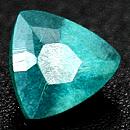|
|
||||||||||||||||
|
||||||||||||||||
|
||||||
|
|
|
|
Rosasite
|
|
| | |
| Discovered in 1908; IMA status: Valid (pre-IMA; Grandfathered) | ||
|
| ||
|
Chemistry |
|
|
| |
|
Cu,Zn2(CO3)(OH)2 | |
|
|
Copper Zinc Carbonate Hydroxide |
|
Molecular Weight: |
222.04 gm |
|
Composition: |
Zinc |
14.72 % |
Zn |
18.33 % |
ZnO |
|
|
Copper |
42.93 % |
Cu |
53.74 % |
CuO |
|
|
Hydrogen |
0.91 % |
H |
8.11 % |
H2O |
|
|
Carbon |
5.41 % |
C |
19.82 % |
CO2 |
|
|
Oxygen |
36.03 % |
O |
|
|
|
|
|
100.00 % |
|
100.00 % |
= TOTAL OXIDE |
|
|
|
||||
|
Classification |
|
|
| |
|
Carbonates | |
|
5/C.01-80 | |
|
|
5 : CARBONATES (NITRATES) |
|
Related to: |
Rosasite Group |
|
Varieties: |
Nickeloan Rosasite |
|
Synonyms: |
Parauricalcite-I |
|
|
|
|
Crystal Data |
|
|
|
|
|
Crystals are acicular, to 0.5 mm; in radial or divergent sprays or globular; compact mammillary to botryoidal crusts and masses, typically fibrous and with warty surfaces. |
|
|
On {100} |
|
|
|
|
|
Physical Properties |
|
|
|
|
|
Distinct/Good in two directions at right angles. |
|
|
Splintery - Thin, elongated fractures produced by intersecting good cleavages or partings. |
|
|
Brittle |
|
|
4.5 |
|
|
4.00 - 4.20 (g/cm3) |
|
|
None |
|
|
Not Radioactive |
|
|
Other: |
Soluble in acids |
|
|
|
|
Optical Properties |
|
|
|
|
|
Blue, Blue-Green to Green, sky-Blue; Colorless to light blue in transmitted light. |
|
|
Translucent |
|
|
Vitreous, Silky |
|
|
1.672 - 1.831 Biaxial ( - ) |
|
|
0.139 - 0.140 |
|
|
Strong; r > v |
|
|
Strong; X = pale emerald-green; Z = dark emerald-green |
|
|
|
|
|
Occurances |
|
|
|
|
|
Geological Setting: |
An uncommon secondary mineral in the oxidized zone of Cu–Zn-bearing deposits, typically formed by zinc-bearing solutions on primary copper minerals; may be of post-mine origin. |
|
Common Associations: |
Malachite, Aurichalcite, Smithsonite, Cerussite, Hydrozincite, Hemimorphite |
|
Common Impurities: |
Mg, Fe |
|
Type Locality: |
Rosas Mine, Narcao, Carbonia-Iglesias Province, Sardinia, Italy |
|
Year Discovered: |
1908 |
|
View mineral photos: | |
|
|
|
|
More Information |
|
|
|
|
|
| |
|
|
|
|
Rosasite
is found in a number of localities worldwide including
the type locality of Rosas mine, Sulcis, Sardinia, Italy.
At a number of places in England, such as Caldbeck Fells,
Cumbria, and mines in Cornwall. Fine examples from Tsumeb,
Namibia. In the USA, from the Kelly mine, Magdalena,
Socorro County, New Mexico; fine specimens from the
Silver Bill mine, Gleeson, and at Bisbee, Cochise County,
in the 79 mine, Gila County, and a number of other places
in Arizona; from the Mohawk mine, San Bernardino County,
California; at Leadville, Lake County, Colorado; from
Majuba Hill, Pershing County, Nevada; in the Hidden
Treasure mine, Ophir district, Tooele County, Utah.
Abundant specimens from the Ojuela mine, Mapimí, Durango,
Mexico. In small amounts from additional localities.
|
|
|
We
have not photographed our Rosasite gems. Please
check back soon. |
